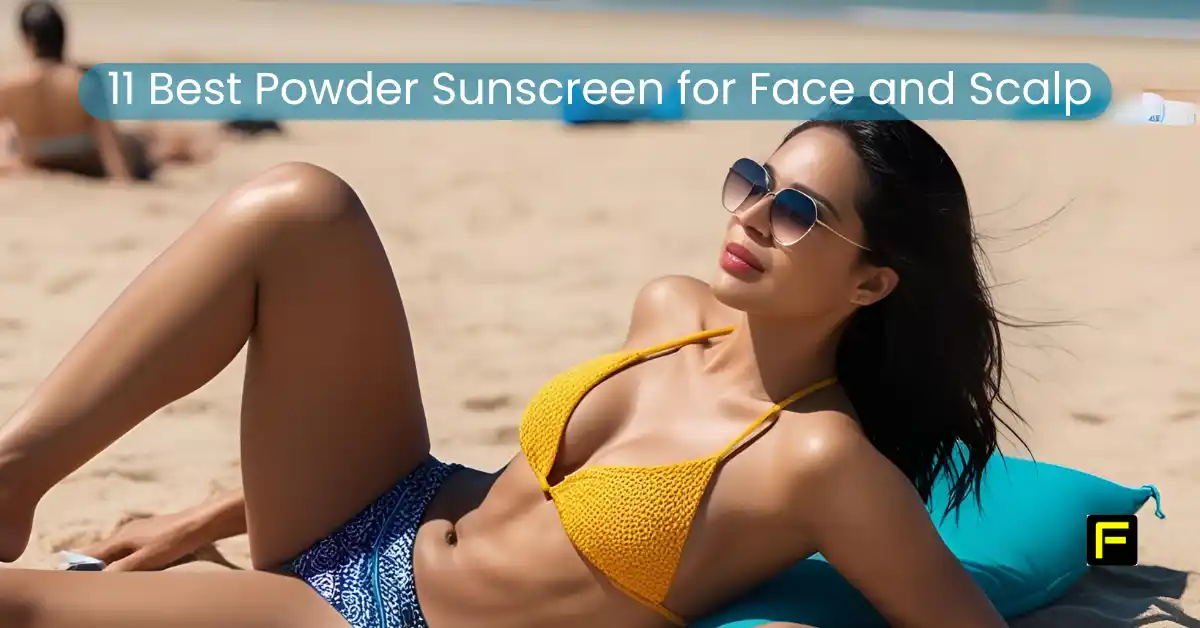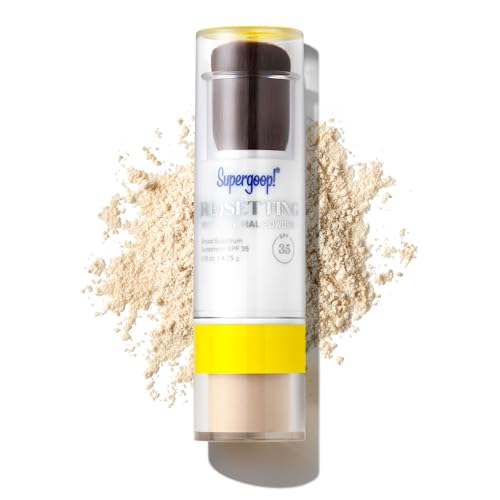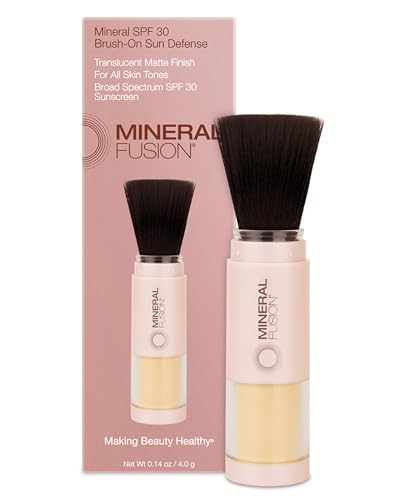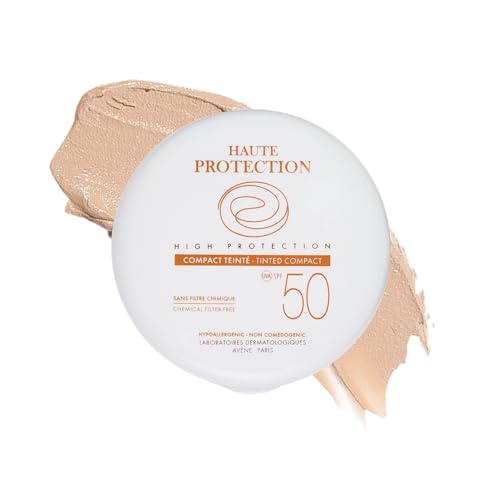Summer is finally here, and that means fun in the sun! But as I’ve gotten older, I’ve learned that protecting my skin isn’t just about avoiding a painful sunburn—it’s about preventing long-term damage and keeping my skin healthy for decades to come. That’s why I’m excited to share everything I’ve discovered about powder sunscreen for face and scalp protection.

When searching for the best powder sunscreen for face and scalp, I’ve found that these innovative products offer unique benefits that traditional sunscreens can’t match. They’re especially handy for those of us over 50 who want effective sun protection without the greasy feeling of lotions or the awkward application of sprays.
Table of Contents
The 11 Best Powder Sunscreens for Face and Scalp
After trying countless options, here are the powder sunscreens I’ve found to be truly worth your money:
1. Colorescience Sunforgettable Total Protection Brush-On Shield SPF 50
This industry leader is my personal gold standard. It provides excellent coverage with a natural finish and offers additional protection against blue light and pollution. I’ve found it lasts longer than most competitors, though at around $69, it’s definitely an investment. The brush applicator works better than many others I’ve tried, distributing powder evenly without clumping. When I’m spending a full day outdoors, this is my go-to.
2. Supergoop! (Re)setting 100% Mineral Powder SPF 35
A close second to Colorescience, this powder contains ceramides that help moisturize while providing sun protection. I appreciate how it comes in multiple shades (light, medium, dark, and translucent). It has a silky feel and absorbs oil beautifully, making it perfect for summer days when I tend to get shiny. Compared to Colorescience, it’s slightly less water-resistant but feels more lightweight on the skin.
3. Hawaiian Tropic Mineral Skin Nourishing Sunscreen Powder Brush SPF 30
My favorite budget-friendly option at under $20! This one has a lovely tropical scent and provides a matte finish that works well on oily skin. The brush isn’t quite as high-quality as the pricier options, but the powder itself is excellent for the price. I keep this in my car for quick touch-ups and don’t worry if it gets lost or damaged. Unlike Supergoop, it only comes in translucent, but that makes it versatile for most skin tones.
4. Brush On Block Mineral Powder Sunscreen SPF 30
This is my pick for active days because it’s genuinely water-resistant (up to 80 minutes). The refillable design makes it more eco-friendly than some other options, and I find the brush distributes product evenly. It’s slightly less mattifying than Hawaiian Tropic but offers better staying power when sweating.
5. ISDIN Mineral Brush Powder SPF 50
My dermatologist recommended this one, and I can see why professionals love it. It offers extremely high protection while feeling virtually weightless. The silky texture blends seamlessly over makeup. It’s more expensive than Hawaiian Tropic but less than Colorescience, making it a good middle-ground option that still feels luxurious.
6. Mineral Fusion Brush-On Powder Sunscreen for Face, SPF 30
This hypoallergenic, non-toxic option has become my go-to recommendation for friends with sensitive skin. It’s a “weightless wonder” that provides multiple benefits beyond sun protection. Unlike Tarte’s product, Mineral Fusion’s formula is enhanced with sea kelp and white tea antioxidants that help fight free radicals while protecting your skin. The translucent formula works beautifully on all skin tones and doesn’t leave any chalky residue. What impresses me most is how it simultaneously provides UVA/UVB protection while controlling shine, blurring pores, and setting makeup. At around $22, it’s more affordable than premium brands like Colorescience while still delivering excellent quality.
7. Derma E Sun Protection Mineral Powder SPF 30
This is my recommendation for those with extremely sensitive skin. It has a minimal ingredient list and is fragrance-free, making it ideal if you’ve had reactions to other sunscreens. It’s not as finely milled as ISDIN or Colorescience, so the finish isn’t quite as smooth, but the gentle formulation makes up for that.
8. Live Tinted Hueguard Invisible Sunscreen Stick SPF 50
While not a traditional powder, this innovative stick format deserves a spot on the list for solving similar problems. This clear, swipe-and-go stick provides SPF 50 protection with no white cast and is truly waterproof for up to 80 minutes. Unlike the matte finish of most powder options, it gives a subtle dewy glow thanks to hydrating cloudberry and dragon fruit extracts. At around $30 it offers excellent value considering its high SPF and portability. The only drawback is it feels slightly greasy initially, but absorbs quickly enough to make it a staple in my beach bag.
9. Jane Iredale Powder-Me SPF 30 Dry Sunscreen
What sets this one apart is the range of tinted options that can double as a light foundation. This is my Sunday brunch favorite when I want minimal makeup with protection. The coverage is sheerer than traditional foundation but provides a nice, natural-looking tint that evens out skin tone while protecting.
10. Avène Mineral High Protection Tinted Compact SPF 50
This European-style compact feels more like traditional makeup than other powder sunscreens. The pressed format makes it less messy than loose powders like Hawaiian Tropic, and the coverage is more substantial. It’s my travel pick because it won’t spill in my luggage and can replace multiple products.
11. Bare Minerals Original Powder Foundation SPF 15
While it has the lowest SPF on the list, I include this because it’s the most widely available and provides excellent coverage as a foundation. I layer this over a liquid sunscreen for everyday wear when I want both makeup and added sun protection. It’s not enough protection on its own for beach days but works well for casual outings.
What is Powder Sunscreen?
Powder sunscreen is exactly what it sounds like—sun protection in powder form. These products typically come in portable containers with built-in brushes for easy application. Most are mineral-based formulas containing active ingredients like:
- Zinc oxide
- Titanium dioxide
- Iron oxides (for blue light protection)
These mineral ingredients create a physical barrier on your skin that reflects and scatters harmful UV rays before they can damage your skin cells. Unlike chemical sunscreens that need to be absorbed into the skin, mineral powder sunscreens work instantly upon application, creating immediate protection against the sun’s harmful rays.
Why Choose the Best Powder Sunscreen for Face and Scalp?
The popularity of powder sunscreens has skyrocketed in recent years, especially during summer months when sun protection becomes even more critical. According to recent market research, the global powder sunscreen market is expected to grow at a rate of 6.5% annually through 2028, indicating strong consumer demand for these convenient products.
Here’s why so many people love them:
- Perfect for reapplication: They won’t mess up your makeup when you need to reapply
- Oil control: They absorb excess oil and provide a matte finish
- No white cast: Most powder formulas go on clear for all skin tones
- Easy to apply to the scalp: They protect your part and hairline without making hair greasy
- Convenient: The brush applicators make them perfect for on-the-go use
As someone who spends most summer weekends at outdoor barbecues, beach trips, and gardening sessions, I’ve found that powder sunscreens solve multiple pain points that traditional sunscreens create. No more greasy hands, streaky makeup, or that sticky feeling that makes you want to wash your face immediately.
Powder vs. Lotion vs. Spray Sunscreens: Which is Better for Summer?
When comparing powder sunscreen to traditional options during hot summer months, each has distinct advantages for different situations.
Powder Sunscreen
- Pros: Easy reapplication, won’t mess up makeup, great for oily skin and scalp
- Cons: May not provide enough initial coverage, difficult to apply sufficient amount
- Summer best for: Midday touch-ups, protecting your part when wearing a ponytail, setting makeup that tends to slide in heat
Lotion Sunscreen
- Pros: Provides thorough coverage, easier to ensure proper application amount
- Cons: Can feel heavy or greasy, difficult to reapply over makeup
- Summer best for: Initial beach or pool application, water activities, high-exposure days
Spray Sunscreen
- Pros: Quick application on large body areas, less messy than lotions
- Cons: Inhalation concerns, difficult to tell if you’ve applied enough
- Summer best for: Quick coverage for kids, hard-to-reach areas, reapplication at the beach
The expert consensus? Powder sunscreens work best as a touch-up option, not as your primary sun protection. Dermatologists recommend applying a traditional cream or lotion sunscreen first, then using powder sunscreen for reapplication throughout the day.
During my family’s annual beach vacation, I’ve developed a system: lotion sunscreen first thing in the morning, spray for large areas when we return from swimming, and powder for face and scalp touch-ups throughout the day. This combination approach provides the most comprehensive protection.
How Soon Does Powder Sunscreen Start Working?
One major advantage of mineral powder sunscreens, especially during summer outdoor activities, is that they start working immediately upon application. Unlike chemical sunscreens that need to be absorbed into the skin (typically requiring 15-30 minutes before sun exposure), mineral powder sunscreens provide instant protection because they create a physical barrier on the skin’s surface.
This immediate protection is critical for summer fun when you might be running late for an outdoor event or need to reapply quickly between activities. I can’t tell you how many times I’ve been grateful for this instant protection when I’ve realized my nose is getting pink after a couple of hours in the sun!
The Perfect Application Technique for Maximum Protection
Getting the most out of your powder sunscreen requires the right application technique. Here’s my step-by-step method developed over years of trial and error:
- Start with clean, dry skin or over makeup that has fully set
- Activate the powder by tapping the closed brush on a hard surface 3-5 times with the brush side facing down
- Check powder flow by running your finger through the bristles—you should see a small puff of powder
- Apply in circular motions using light pressure across all exposed areas
- Pay special attention to commonly missed spots like hairline, ears, and the sides of your neck
- For scalp application, create several small parts in your hair and brush along each part line
- Build coverage with 2-3 passes to ensure adequate protection
- Reapply every 2 hours or more frequently when sweating or after water exposure
For summer beach days, I keep a small handheld mirror in my beach bag so I can check my application and make sure I haven’t missed any spots. This is especially important for powder products since it can be harder to see where you’ve already applied them.
How Often Do You Need to Reapply During Summer Activities?
Just like with any sunscreen, reapplication is crucial for maintaining protection, especially during summer activities when sun exposure is highest. According to the American Academy of Dermatology, sunscreen should be reapplied:
- Every 2 hours during normal outdoor activities
- Every 80 minutes (or sooner) during swimming or heavy sweating
- Immediately after towel-drying
A critical fact to know: Studies show most people don’t apply enough powder to get the full SPF protection listed on the label. Research published in the Journal of the American Academy of Dermatology found you’d need to apply about 14 times more powder than people typically use to get the advertised SPF level! This is why I always recommend being extremely generous with your application.
During summer picnics or beach outings, I set a timer on my phone to remind me when it’s time to reapply. One of the biggest mistakes people make is applying sunscreen once in the morning and thinking they’re protected all day.
Is Powder Sunscreen Waterproof for Summer Swims?
Most powder sunscreens are not fully waterproof, though some formulas claim to be water-resistant for up to 40 or 80 minutes. The reality is that powder sunscreens are more susceptible to being washed away by water or sweat than their lotion counterparts—a critical consideration during hot summer months.
If you’re planning a day of swimming or water sports this summer, your best strategy is to:
- Start with a water-resistant lotion or cream sunscreen (SPF 50+)
- Reapply that same water-resistant product after water activities
- Use powder sunscreen for quick touch-ups when your skin is dry
- Keep a hat nearby for additional protection when powder isn’t practical
For summer pool parties or beach days, I’ve found that having all three formats (lotion, spray, and powder) gives me the flexibility to maintain protection regardless of the activity.
Who is Powder Sunscreen Best For During Summer Months?
Powder sunscreen is particularly ideal for:
- People with oily or acne-prone skin who want sun protection without added shine during hot summer days
- Makeup wearers who need to reapply sunscreen throughout outdoor summer events
- Those with thinning hair or exposed scalps who need protection without greasy products for summer hats
- Active individuals who want quick, convenient reapplication during summer sports
- People with sensitive skin who may react to chemical sunscreen ingredients commonly found in traditional formulas
I’ve found that as I’ve gotten older, powder sunscreens have become a staple in my summer beauty routine because they don’t settle into fine lines like some creamy sunscreens can. They’re also ideal for summer travel since they’re not subject to the same TSA liquid restrictions as traditional sunscreens.
The Importance of Early Application Before Summer Outings
One common mistake people make, especially during summer, is waiting until they’re at the beach or pool to apply sunscreen. The difference between applying sunscreen ahead of time versus waiting until you’re already in the sun is significant:
- Applying ahead of time: Ensures full coverage, allows chemical sunscreens time to activate, and establishes a habit of protection
- Waiting until at the beach: Increases chances of missed spots, initial sun exposure without protection, and hurried application
Even with mineral powder sunscreens that work immediately, it’s best to apply before you head outdoors to ensure thorough coverage and make sun protection a non-negotiable part of your summer routine.
I’ve made it a habit to apply sunscreen at home as part of my morning routine during summer, regardless of my plans for the day. This way, even if plans change and I unexpectedly spend time outdoors, my skin is already protected.
Summer Skin Damage: Shocking Statistics You Need to Know
The importance of sunscreen, including powder formats, becomes clear when you look at these alarming statistics about sun damage:
- 90% of skin aging is caused by sun exposure, not the natural aging process
- According to the Skin Cancer Foundation, more than 9,500 people are diagnosed with skin cancer every day in the United States
- Only 11% of Americans use sunscreen daily, despite recommendations from dermatologists
- Adults over 50 have a higher risk of developing skin cancer due to cumulative sun damage over decades
- Up to 80% of the sun’s UV rays can penetrate through clouds, meaning you need protection even on overcast summer days
- A person’s risk for melanoma doubles if they’ve had more than five sunburns in their lifetime
These statistics highlight why finding a sunscreen you’ll actually use consistently—like a convenient powder formula—is so crucial for long-term skin health.
Addressing Common Pain Points with Powder Sunscreen
Many people struggle with traditional sunscreens, especially during summer months when heavier products feel uncomfortable. Here’s how powder sunscreens can solve specific pain points:
Problem: Greasy, shiny skin from traditional sunscreens
Solution: Powder sunscreens absorb excess oil instead of adding moisture, creating a matte finish even in humidity.
Problem: Sunscreen running into eyes during summer sweating
Solution: Powder formulas stay put and won’t drip or migrate, even during intense outdoor activities.
Problem: Reapplying over makeup seems impossible
Solution: Powder sunscreens can be applied over makeup without disturbing it, making midday protection simple.
Problem: Scalp burns along your part when outdoors
Solution: Powder formulas can be easily brushed along the hairline and part without making hair greasy or flat.
Problem: Traditional sunscreens causing breakouts
Solution: Most powder sunscreens are non-comedogenic and won’t clog pores, making them ideal for acne-prone skin.
I struggled with many of these issues until discovering powder sunscreen. Now, I can enjoy summer activities without worrying about my sunscreen melting off, causing breakouts, or making me look like a greasy mess in photos.
Final Thoughts on Powder Sunscreens for Summer Protection
Powder sunscreen for face and scalp protection offers a convenient, effective option for keeping your skin safe during summer months, especially when used as part of a comprehensive sun protection routine. While they shouldn’t replace your primary sunscreen, they’re invaluable for touch-ups throughout the day and for protecting often-neglected areas like the scalp.
As we age, protecting our skin becomes even more important, and having multiple tools in our sun protection arsenal makes it easier to stay protected no matter what summer activities we’re enjoying.
Remember that the best sunscreen is ultimately the one you’ll actually use consistently. If powder sunscreen helps you maintain better sun protection habits during the summer months, then it’s a worthwhile addition to your skincare routine.
Have you tried powder sunscreen for your summer activities? I’d love to hear about your experiences and favorite brands in the comments below!
This article is intended for informational purposes only and is not a substitute for professional medical advice. Always consult with a dermatologist for personalized recommendations regarding your skin health needs.
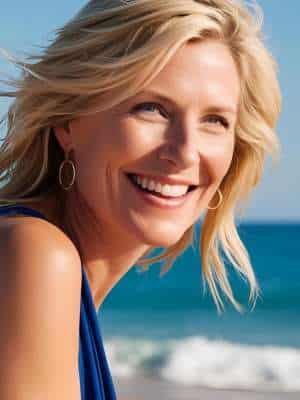
Claudia Faucher is a full-time fitness training expert and lifestyle blogger. She is also been a certified Les Mills BodyPump instructor for the past 5 years and a fitness instructor for over 20 years. Claudia is a personal trainer and creates fitness training programs for seniors and people of all ages. She likes to use her skills and experiences to help others on their fitness journeys.
Last update on 2025-11-28 / Affiliate links / Images from Amazon Product Advertising API
